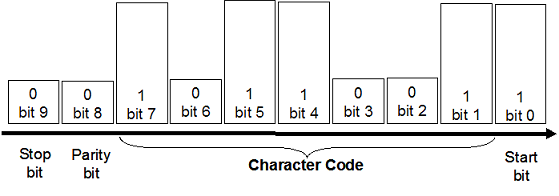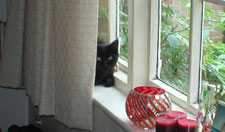Computer Science
Communication Methods
Data Transmission
We use this term to refer to the exchange of data between sending and receiving devices across a transmission medium.
Serial Data Transmission

In serial data communication data is sent via an interface one bit at a time over a single wire from the source to the destination.
Serial data communication is used for long distance communication. All transmission methods are affected by distance - it is more straightforward to regenerate a single signal to prevent signal strength dropping too far for successful communication. It also reduces the requirement for cabling.
Parallel Data Transmission

In the days before USB, printers were connected to PCs via the parallel port. The connecting cable consists of a group of wires in order to transmit several bits simulataneously.
Small differences in the electrical resistance of the wires mean that each bit might arrive at a slightly different time. This is called skew and makes parallel data communication reliable over short distances but not over longer distances.
Baud Rate
The term baud rate refers to the rate at which the signal changes. The unit of measure, 1 baud is equivalent to one signal change per second.
Bit Rate
The bit rate is the number of bits transmitted each second. When a single signal is sent at a time, the baud rate and bit rate are the same.
Bandwidth
The term bandwidth is used to refer to the range of frequencies that can be transmitted over the medium. This is measured in hertz (Hz). The term is misused by ISPs - even the wrong units are used.
There is a relationship between bandwidth and bit rate. The higher the bandwidth, the higher the bit rate.
Bit Rate = Baud Rate * Number of bits per signal
Latency
This term is used to refer to the delay that occurs between initiating something and the first effects beginning. In communication over wide distances, the effect is increased.
Asynchronous Data Transmission
In many situations, the receiving device does not know exactly when a message is going to be received. You don't, for example, type on a keyboard with a precise interval between each keypress and therefore each byte sent to the keyboard controller. The data transmission in this case is asynchronous since the transmitting system is not synchronised with the receiving system. A method for ensuring that the receiving system can correctly identify which digit in the communication belongs needs to be used.
Most systems for asynchronous data transmission involve the use of start and stop bits. The start bit is used to synchronize a clock in the receiving device. Once that has been received, timed periods will be used to receive the remaining bits in the transmission. A stop bit indicates the end of the data.

Parity Checking
Computers rely on the fact that data is transmitted correctly. This is normally achieved through methods which aim to reduce the number of errors.In odd parity, the first/leftmost bit (Most Significant Bit) or the last/rightmost bit (Least Significant Bit) is altered to ensure that the total number of on bits is an odd number.
In even parity, the first/leftmost bit (Most Significant Bit) or the last/rightmost bit (Least Significant Bit) is altered to ensure that the total number of on bits is an even number.
By examining the bits in each byte received, the receiving device can check that the data has been transmitted correctly. The parity bit is ignored thereafter. If an error is received, the message can be re-transmitted.
Handshaking
In order to communicate succesfully, devices need to know that the other device is ready to transmit or receive data. They also need prior knowledge of the type of parity checking used and on which bits. The value and number of start and stop bits also needs to be agreed.
Handshaking is where devices exchange information about the communication methods they use. A protocol is an agreed set of rules for communication between devices that are needed to ensure successful communication.
This is required to allow communication between devices built by different manufacturers.
Baseband
In this mode of operation, the whole of the bandwidth of the cable is dedicated to a single data channel. Bit values of 1 or 0 are represented by the presence or absence of voltage in the cable. The signals are relatively quick but can only be sent over distances up to 300m without booster equipment. Baseband tends to be used over short distances since it can provide speedy communication without a large cost.
Broadband
The medium of transmission (such as a wire or fibre-optic cable) carries multiple messages at a time, each message modulated on its own carrier frequency. The bit values of 1 or 0 are represented by variations in the fixed carrier wave. Broadband is used for longer distances.

